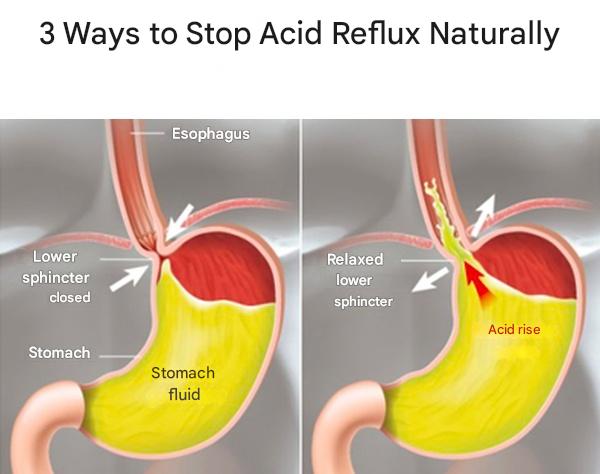3 Ways to Stop Acid Reflux Naturally

If you experience heartburn, you’re not ready for supplementation yet. Take one tablespoon of ACV with each meal for 4 to 6 weeks to improve your digestion. Dilute it in water until you can tolerate it. If you don’t experience any discomfort after drinking ACV, you’re ready to take 1 to 2 capsules of betaine HCL with a meal. This helps reduce bloating and discomfort after eating protein-rich foods. You may need to increase your dosage until you no longer experience heartburn or discomfort, then decrease your dosage over time.
2. Get Enough Potassium, Sodium, and Zinc in Your Diet
Next, you need to make sure you’re getting enough potassium, sodium, and zinc in your diet. These nutrients are needed by your body to produce stomach acid.
3. Reduce Your Stress Levels
Third, you’ll want to reduce your stress levels. Stress can cause your stomach muscles to tighten. Researchers found that people with acid reflux and GERD who were anxious and stressed became more sensitive to smaller amounts of acid in the esophagus and reported more painful symptoms.
Four Ways to Reduce Inflammation and Relieve the Pain and Discomfort of Acid Reflux
1. Avoid Foods That Trigger or Worsen Symptoms of Acid Reflux and GERD
Reduce your carbohydrate intake (especially refined carbohydrates) as they can cause bacterial overgrowth, gas, and bloating. Choose a gluten-free diet, as foods containing gluten are a common cause of heartburn. Limit your intake of
High-fat foods stimulate the release of a hormone called cholecystokinin (CCK), which relaxes the LES and triggers heartburn. Also avoid foods and drinks that trigger acid reflux, such as mint, coffee, carbonated drinks, chocolate, alcohol, citrus fruits, onions, garlic, tomatoes, peppers, and spicy foods.
2. Add these anti-inflammatory foods and drinks to soothe acid reflux and help regulate stomach acid production:
– Root vegetables, leafy greens, and legumes such as potatoes, sweet potatoes, turnips, carrots, spinach, broccoli, green peas, lentils, and mushrooms. These foods are high in fiber and aid digestion. – Non-citrus, low-acid fruits such as watermelon, apples, bananas, and pears. Whole grains rich in fiber like oats, brown rice, and quinoa. – Fermented foods like kimchi, sauerkraut, and yogurt. These foods contain probiotics that help increase stomach acid. – Lean, low-fat proteins like chicken, fish, seafood, tofu, and egg whites that are baked, grilled, poached, or boiled. Ginger and chamomile tea, along with plenty of clean water.
3. Change your lifestyle
If heartburn is keeping you up at night, try sleeping on your left side. Sleeping on your right side can worsen reflux symptoms because it makes it easier for stomach acid to back up into the esophagus and cause heartburn. For the same reason, you can elevate the head of your bed or use a wedge pillow to raise your upper body while you sleep.